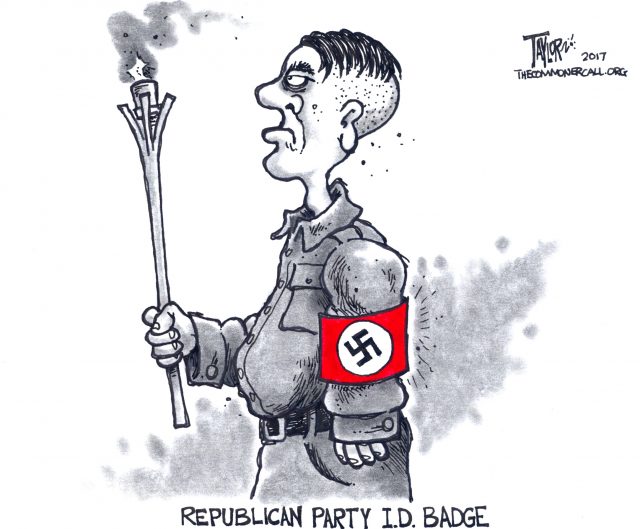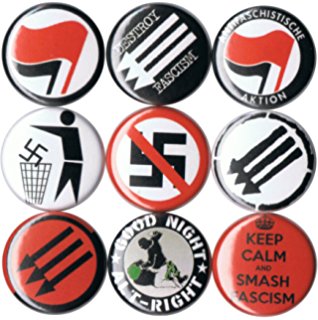
By Will Carless
Center of Investigative Journalism (1/8/8)
There was a time when it was hard to find anyone in California who readily embraced the term “antifa.”
Leftist activists, even in the uber-liberal San Francisco Bay Area, hemmed and hawed about using the moniker. Branding themselves as antifa – shorthand for anti-fascist – seemed a little too hucksterish. It played into the hands of the enemy, the so-called “alt-right,” who had spent the previous few months trying to paint the antifa as a shadowy terrorist movement.
But then in August, a man plowed into a crowd of left-wing protesters at a white supremacist rally in Charlottesville, Virginia, killing a woman and injuring dozens of others. The next morning, Oakland activist John Cookenboo painted one word on the military-grade helmet he wears to protests:
Antifa.
Around the Bay, more militant members of the burgeoning local antifa movement stepped things up. Spurred on by the Virginia attack, a core cell formed a Rapid Response Team named for the victim: the Heather Heyer Brigade. Its goal: to seek out anyone its members consider “Nazis” and confront them, with violence if necessary.
“We’ll go to their house, I’ll put it that way,” one activist said. “We’ll go to their house.”
*****
The antifa, which began as a largely misunderstood, shadowy concept largely touted by right-wing news anchors, spent much of 2017 fusing into a movement known across the country. Perhaps nowhere in America has the metamorphosis of these black-clad protesters been more visible than in the Bay Area.
A seminal moment came in late summer in opposition to a right-wing rally planned for Berkeley two weeks after Charlottesville – a little more than a half-mile and a half-century from the birthplace of the 1960s free speech movement.

“I think about the Purple Heart my grandfather got trying to fight against this fascism that is in a new phase now,” he said. “It’s sad to me that we have to still be fighting it in 2017.”
Hundreds of antifa marched toward the main protest in militant “black bloc” formation, waving flags bearing antifa logos. As they approached the column of more moderate protesters already headed toward Berkeley City Hall, they pounded on their shields, chanting:
“Ah – anti! – Anti-fascista! Ah – anti! – Anti-fascista!”
From small children to white-haired, tie-dye-wearing peaceniks, the crowd eagerly joined in: “Anti-fascista! Anti-fascista!”
Long a breeding ground for militant activism – from the Black Panther Party to branches of the Occupy and Black Lives Matter movements – the Bay Area has seen its radical roots reinvigorated by a new brand of political action with an evocative history.
The mainstream media is eager to label this a natural continuum, but the reality of the antifa is far more complex than any television soundbite. Months of interviewing self-proclaimed members of the antifa uncovered a loosely organized tribe of individuals whose philosophies and tactics run the gamut from literally singing “Kumbaya” at rallies to hunting down Nazis to break their bones – and who recently have been united in part by a modicum of mainstream acceptance.
“I’m one of these people who for the last 50 years has wanted to see this sort of radical, progressive activity that we had in the late ’60s and early ’70s, and I think to some extent, we are seeing that now,” said Dan Siegel, a civil rights lawyer and activist who attended UC Berkeley from 1967 to 1970 and who says he “got to know some of the Panthers.”
“I’m sure there are a lot of people that are happy about it.”
‘Until the day I die’
John Cookenboo and his friends Moira Van de Walker and Vincent Yochelson are typical of many antifa activists in the Bay Area: They’re in their 20s, holding down largely casual part-time jobs. Cookenboo, 28, works in the marijuana industry when he’s not taking care of an elderly relative in rural Mendocino County. Yochelson, 23, has a number of jobs, from catering to gardening. Van de Walker, 22, helps at a local punk music collective.
They represent a cross-section of the local antifa movement in other ways, too. They’re young, passionate and angry. But most of all, they’re fiercely protective of their community. Emphasis on the fierce.
And while they’re not exactly organized, they are ready to fight.
Just before noon April 15, the three friends skirted an orange police barricade in downtown Berkeley, searching for a way into the nucleus of a protest they had anticipated for weeks – one that would become infamous enough to earn its own name: the Battle of Berkeley.
As the first spiky tickles of pepper spray crept through the black bandannas tied across their faces, the trio of 20-somethings realized with a jolt that what had begun as a right-wing “free speech” protest was exploding into a riot. The crowd of hundreds of right-wing demonstrators and left-wing counterprotesters had gone berserk. Bodies were hemorrhaging through the barricade into the surrounding streets.
“People broke out of the barrier, and it all started going to shit over there. People were throwing fireworks, smoke bombs – shit like that. Pepsi cans,” Van de Walker recalled. “We all decided, this is getting a little hot here. We should go grab our stuff.”
In the days leading up to the protest, they had raided supermarket dumpsters, fashioning DIY riot gear from the detritus of capitalism: lightweight shields made from scrap aluminum, high-density foam and duct tape. Construction and snowboard helmets spray-painted black. The gear was stashed in the trunk of Cookenboo’s car a few blocks away.
The three returned decked out like dystopian knights. But they never learned whether their homemade shields could withstand the blow of a baseball bat or the stab of a knife. They were arrested before they could join the fray and spent the next day and a half locked up on charges of committing a felony while wearing a mask and possessing a switchblade.
They remain unapologetic for acting, as they see it, in defense of their friends and neighbors.
“I’ve never gone to any antifa meetings,” said Yochelson, who lives in West Oakland. “But yeah, I don’t appreciate the idea of people forcing their ideals on my community and the people I live around – being here to be violent and throw nonsense and verbal litter all over the place. I don’t need that, don’t want it, and I don’t think anyone in my community wants it.”
Van de Walker said she’s fighting a noble cause that she’s not going to give up anytime soon, even if it means risking her life.
“I’m going to do everything in my power to make sure my community, my friends, my family are all safe,” she said. “And I will do that until the day I die.”
They are concerned about other political issues, too, such as a lack of affordable housing in the Bay Area and police treatment of people of color. But ultimately, their rising militancy feeds on the recent provocation of right-wing activists.
For some other antifa activists in the Bay Area, however, the fight between fascism and anti-fascists has been raging a lot longer.
The Nazi fighter
The first thing Dominic will tell you is that he has been fighting Nazis for more than 20 years.
“I started in ’94,” he said. “Whenever they come to Berkeley, I have no problem physically encountering them.”
Dominic is a heavily muscled Bay Area activist in his late 30s with a thick beard and an intense stare. In return for an agreement not to name him in this story, he freely described his illegal activities. Facing off against white supremacists and fascists in the streets, he says, renews the battle his grandfather fought on the beaches of Normandy in World War II.
“I think about the Purple Heart my grandfather got trying to fight against this fascism that is in a new phase now,” he said. “It’s sad to me that we have to still be fighting it in 2017.”
As one of the original activists with Anti-Racist Action, the group largely identified with bringing the concept of anti-fascism to America, Dominic said he spent years outing white supremacists to their neighbors, co-workers and bosses. He and other activists also lobbied California nightclubs to ban neo-Nazi punk bands.
To Dominic, 2017 felt like déjà vu. Modern racists might eschew swastikas and overt neo-Nazi symbology, he said, but they unite under new racist symbols such as the Pepe the Frog character and the Kek flag, which mirrors a Nazi war flag. Early in the summer, Dominic focused on educating the public about the true meaning of these symbols, to expose these new racists.
But a few weeks later, post-Charlottesville, Dominic’s tactics had escalated from education to action.
In the runup to two planned right-wing rallies in late August, one in San Francisco, one in Berkeley, Dominic and other local antifa had organized their Rapid Response Team. The Heather Heyer Brigade consisted of a few dozen antifa who – acting on intel from a network of informants from watchful bartenders to activists scouring social media accounts – were on call to respond to reports of white supremacists or fascists on their home turf.
On Saturday, Aug. 26, Dominic allowed a reporter, producer and photographer to follow him around San Francisco, hopscotching through the city as he and his crew responded to reports of what they consider “Nazi” activity. On Signal, a secure messaging app, Dominic shared reports of his activities and the coordinates of where to meet next.
At one point, he messaged that they were descending on a small group of right-wing protesters who had set up a banner at Fisherman’s Wharf. It read, “Love Free Speech, Unafraid of Fake News, Ask Me My Point of View.”
Soon, the conservative protesters were surrounded by the black-clad group, screaming at them to get out of town. Mike Gaughan, a pedicab driver who witnessed the confrontation, said the antifa “were way more aggressive and intimidating than the protesters, to be honest.”
Afterward, Dominic was unrepentant. “We shut them down,” he said. The protesters had been met with jeers, not fists, he said, because they weren’t on the brigade’s hit list of right-wing targets.
Less than 24 hours later, other targets didn’t fare so well.
‘They’ve been chased out and they’re bloody’
Joey Gibson may be best described as an agitator.
The Oregon activist, who founded the right-wing Patriot Prayer group, has made it clear that his goal is to rile up antifa activists. He wants “to expose them for who they are,” he told Reveal radio host Al Letson in August. That earned Gibson the central spot on the brigade’s “Know Your Nazi” flier.
But the San Francisco rally Gibson had planned for that Saturday in San Francisco fizzled. Gibson popped up here and there on social media but remained elusive in person, out of range of the Heather Heyer Brigade.
The next day, Gibson came to them.
While the counterprotests against a planned – and also canceled – right-wing rally in central Berkeley that day were largely peaceful, Gibson and his de facto bodyguard, Tusitala Toese – a large Samoan American man who goes by the nickname “Tiny” – waited until Berkeley police stood down from their positions before wading into the middle of the most militant group of antifa.
Gibson and Toese previously had said they were looking for moderate dialogue by coming to the Bay Area from Portland. “I’m not interested in extremists,” Gibson said in an interview a week before.
But in Berkeley, the two agitators ignored thousands of moderate leftists. Instead, with Toese decked out in football pads and goggles, they headed straight for the antifa inside Martin Luther King Jr. Civic Center Park – a black-clad pack that included Dominic.
The result was predictable.
Gibson, Toese and Keith Campbell – a video blogger who previously had goaded the antifa on Twitter to come and fight in Berkeley – were pushed, punched, pepper-sprayed and chased out of the park.
Gibson and Toese retreated behind a line of riot police. Campbell ended up flat on the street, being kicked and punched, before Letson, who was covering the rally for Reveal, shielded Campbell with his body.
To outsiders, the turn of events seemed like a public relations nightmare for the antifa. But for Dominic, the protests were cause for celebration. Knocking back a cold Heineken less than a block from the scene, Dominic, bloody-knuckled, reflected on the day’s events. He boasted that he had personally chased away Gibson.
“The people on our list are targets, so they got injured,” he said. “They’ve been chased out and they’re bloody. They know they can’t come to the Bay Area and spout that hate.”
He was unhappy with Letson for interfering in the beating, saying of Campbell: “What does he deserve? He deserves potentially stitches or broken bones.”
Gibson also considered the day a success. He said he achieved exactly what he had hoped to do: to make the antifa look like unhinged, undisciplined bullies who attack “innocent patriots” trying to initiate a cordial debate.
Before long, Gibson was proven right – at least in the court of public opinion.
‘They’re cowards’
In the hours following the Berkeley protests, Fox News’ Tucker Carlson lavished praise and sympathy on Gibson and Campbell and branded the antifa who attacked them as “thugs.”
“They’re cowards,” he said.
Carlson failed to mention Gibson’s history of antagonism or Campbell’s Islamophobia – or his many threats and goads to the antifa on Twitter.
This unnuanced narrative took hold in the mainstream media. “How Antifa Violence Has Split the Left,” read a Wall Street Journal headline.
Democrats lambasted the antifa. Berkeley Mayor Jesse Arreguin turned his back. Arreguin previously had echoed antifa perspectives in trying to block the Aug. 27 right-wing rally. But in the aftermath, he called the group a gang. House Minority Leader Nancy Pelosi issued a statement saying the antifa “deserve unequivocal condemnation, and the perpetrators should be arrested and prosecuted.”
As the backlash built, Politico reported that federal law enforcement had set its sights on the antifa as well.
The more moderate leftists who had marched at the Aug. 27 counterprotest looked on in disbelief. Showing Up for Racial Justice – the de facto organizers – rushed to the antifa’s defense.
“Many of us were not aware until today of the crucial role that antifa have been playing to defend communities against white supremacist violence, at great personal risk,” said a statement attributed to Isaac Lev Szmonko of the Catalyst Project, an anti-racist organizing and education collective.
“Today we saw them put their bodies on the line to contain and remove violent threats one after the other in situations that could have become very dangerous, especially for the people of color, queer and transgender people, and women who were present,” the statement said. “People were very grateful for the protection antifa offered.”
For his part, Dominic remained defiant, riding on the hoots and high fives that had greeted the arrival of the black bloc that day, as well as the violence that followed as the antifa took on the right-wing agitators.
“I think the only way to crush these movements is like we did in the ’80s and ’90s, by actually confronting them and showing them that we’re not scared,” he said. “That means going there but not initiating – letting them be the tough guys – and then knocking them down to size.”
(Commoner Call cartoon by Mark L. Taylor, 2017. Open source and free to use with link to www.thecommonercall.org )
*****
Meet Antifa’s Secret Intel Weapon Against Far-Right Extremists

By Doug Bock Clark
Wired (1/16/18)
THE EMAIL ARRIVED just as Megan Squire was starting to cook Thanksgiving dinner. She was flitting between the kitchen, where some chicken soup was simmering, and her living room office, when she saw the subject line flash on her laptop screen: “LOSer Leak.” Squire recognized the acronym of the League of the South, a neo-Confederate organization whose leaders have called for a “second secession” and the return of slavery. An anonymous insider had released the names, addresses, emails, passwords, and dues-paying records of more than 4,800 members of the group to a left-wing activist, who in turn forwarded the information to Squire, an expert in data mining and an enemy of far-right extremism.
Ultimately, Squire sees her work as a type of “fusion center”—a government term for a data center that integrates intelligence from different agencies—for groups combating white nationalism.
Fingers tapping across the keyboard, Squire first tried to figure out exactly what she had. She pulled up the Excel file’s metadata, which suggested that it had passed through several hands before reaching hers. She would have to establish its provenance. The data itself was a few years old and haphazardly assembled, so Squire had to rake the tens of thousands of information-filled cells into standardized sets. Next, she searched for League members near her home of Gibsonville, North Carolina. When she found five, she felt a shiver. She had recently received death threats for her activism, so she Googled the names to find images, in case those people showed up at her door. Then she began combing through the thousands of other names. Two appeared to be former South Carolina state legislators, one a firearms industry executive, another a former director at Bank of America.
Once she had a long list of people to investigate, Squire opened a database of her own design—named Whack-a-Mole—which contains, as far as anyone can tell, the most robust trove of information on far-right extremists. When she cross-checked the names, she found that many matched, strengthening her belief in the authenticity of the leak. By midafternoon, Squire was exchanging messages via Slack with an analyst at the Southern Poverty Law Center, a 46-year-old organization that monitors hate groups. Squire often feeds data to the SPLC, whose analysts might use it to provide information to police or to reveal white supremacists to their employers, seeking to get them fired. She also sent several high-profile names from the list to another contact, a left-wing activist who she knew might take more radical action—like posting their identities and photos online, for the public to do with what it would. …
From Wired: The Free Speech Issue
- Tech, Turmoil, and the New Censorship: Zeynep Tufekci explores how technology is upending everything we thought we knew about free speech.
- “Nice Website. It Would Be a Shame if Something Happened to It.”: Steven Johnson goes inside Cloudflare’s decision to let an extremist stronghold burn.
- Please, Silence Your Speech: Alice Gregory visits a startup that wants to neutralize your smartphone—and un-change the world.
- The Best Hope for Civil Discourse on the Internet … Is on Reddit: Virginia Heffernan submits to Change My View.
- 6 Tales of Censorship: What it’s like to be suspended by Facebook, blocked by Trump, and more, in the subjects’ own words.

